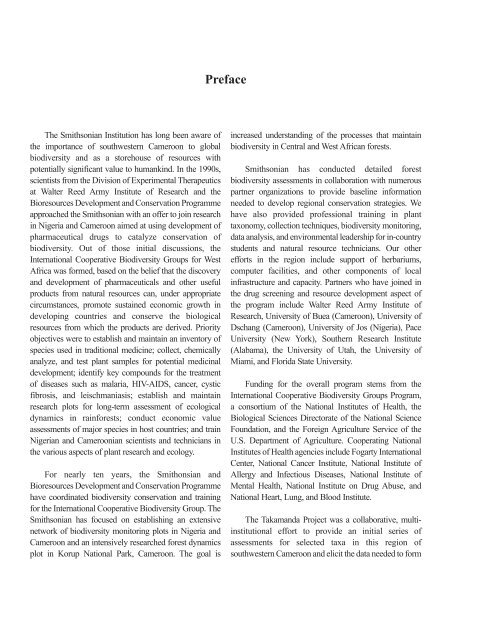Fisheries in the Southern Border Zone of Takamanda - Impact ...
Fisheries in the Southern Border Zone of Takamanda - Impact ...
Fisheries in the Southern Border Zone of Takamanda - Impact ...
You also want an ePaper? Increase the reach of your titles
YUMPU automatically turns print PDFs into web optimized ePapers that Google loves.
The Smithsonian Institution has long been aware <strong>of</strong><br />
<strong>the</strong> importance <strong>of</strong> southwestern Cameroon to global<br />
biodiversity and as a storehouse <strong>of</strong> resources with<br />
potentially significant value to humank<strong>in</strong>d. In <strong>the</strong> 1990s,<br />
scientists from <strong>the</strong> Division <strong>of</strong> Experimental Therapeutics<br />
at Walter Reed Army Institute <strong>of</strong> Research and <strong>the</strong><br />
Bioresources Development and Conservation Programme<br />
approached <strong>the</strong> Smithsonian with an <strong>of</strong>fer to jo<strong>in</strong> research<br />
<strong>in</strong> Nigeria and Cameroon aimed at us<strong>in</strong>g development <strong>of</strong><br />
pharmaceutical drugs to catalyze conservation <strong>of</strong><br />
biodiversity. Out <strong>of</strong> those <strong>in</strong>itial discussions, <strong>the</strong><br />
International Cooperative Biodiversity Groups for West<br />
Africa was formed, based on <strong>the</strong> belief that <strong>the</strong> discovery<br />
and development <strong>of</strong> pharmaceuticals and o<strong>the</strong>r useful<br />
products from natural resources can, under appropriate<br />
circumstances, promote susta<strong>in</strong>ed economic growth <strong>in</strong><br />
develop<strong>in</strong>g countries and conserve <strong>the</strong> biological<br />
resources from which <strong>the</strong> products are derived. Priority<br />
objectives were to establish and ma<strong>in</strong>ta<strong>in</strong> an <strong>in</strong>ventory <strong>of</strong><br />
species used <strong>in</strong> traditional medic<strong>in</strong>e; collect, chemically<br />
analyze, and test plant samples for potential medic<strong>in</strong>al<br />
development; identify key compounds for <strong>the</strong> treatment<br />
<strong>of</strong> diseases such as malaria, HIV-AIDS, cancer, cystic<br />
fibrosis, and leischmaniasis; establish and ma<strong>in</strong>ta<strong>in</strong><br />
research plots for long-term assessment <strong>of</strong> ecological<br />
dynamics <strong>in</strong> ra<strong>in</strong>forests; conduct economic value<br />
assessments <strong>of</strong> major species <strong>in</strong> host countries; and tra<strong>in</strong><br />
Nigerian and Cameroonian scientists and technicians <strong>in</strong><br />
<strong>the</strong> various aspects <strong>of</strong> plant research and ecology.<br />
For nearly ten years, <strong>the</strong> Smithonsian and<br />
Bioresources Development and Conservation Programme<br />
have coord<strong>in</strong>ated biodiversity conservation and tra<strong>in</strong><strong>in</strong>g<br />
for <strong>the</strong> International Cooperative Biodiversity Group. The<br />
Smithsonian has focused on establish<strong>in</strong>g an extensive<br />
network <strong>of</strong> biodiversity monitor<strong>in</strong>g plots <strong>in</strong> Nigeria and<br />
Cameroon and an <strong>in</strong>tensively researched forest dynamics<br />
plot <strong>in</strong> Korup National Park, Cameroon. The goal is<br />
Preface<br />
<strong>in</strong>creased understand<strong>in</strong>g <strong>of</strong> <strong>the</strong> processes that ma<strong>in</strong>ta<strong>in</strong><br />
biodiversity <strong>in</strong> Central and West African forests.<br />
Smithsonian has conducted detailed forest<br />
biodiversity assessments <strong>in</strong> collaboration with numerous<br />
partner organizations to provide basel<strong>in</strong>e <strong>in</strong>formation<br />
needed to develop regional conservation strategies. We<br />
have also provided pr<strong>of</strong>essional tra<strong>in</strong><strong>in</strong>g <strong>in</strong> plant<br />
taxonomy, collection techniques, biodiversity monitor<strong>in</strong>g,<br />
data analysis, and environmental leadership for <strong>in</strong>-country<br />
students and natural resource technicians. Our o<strong>the</strong>r<br />
efforts <strong>in</strong> <strong>the</strong> region <strong>in</strong>clude support <strong>of</strong> herbariums,<br />
computer facilities, and o<strong>the</strong>r components <strong>of</strong> local<br />
<strong>in</strong>frastructure and capacity. Partners who have jo<strong>in</strong>ed <strong>in</strong><br />
<strong>the</strong> drug screen<strong>in</strong>g and resource development aspect <strong>of</strong><br />
<strong>the</strong> program <strong>in</strong>clude Walter Reed Army Institute <strong>of</strong><br />
Research, University <strong>of</strong> Buea (Cameroon), University <strong>of</strong><br />
Dschang (Cameroon), University <strong>of</strong> Jos (Nigeria), Pace<br />
University (New York), Sou<strong>the</strong>rn Research Institute<br />
(Alabama), <strong>the</strong> University <strong>of</strong> Utah, <strong>the</strong> University <strong>of</strong><br />
Miami, and Florida State University.<br />
Fund<strong>in</strong>g for <strong>the</strong> overall program stems from <strong>the</strong><br />
International Cooperative Biodiversity Groups Program,<br />
a consortium <strong>of</strong> <strong>the</strong> National Institutes <strong>of</strong> Health, <strong>the</strong><br />
Biological Sciences Directorate <strong>of</strong> <strong>the</strong> National Science<br />
Foundation, and <strong>the</strong> Foreign Agriculture Service <strong>of</strong> <strong>the</strong><br />
U.S. Department <strong>of</strong> Agriculture. Cooperat<strong>in</strong>g National<br />
Institutes <strong>of</strong> Health agencies <strong>in</strong>clude Fogarty International<br />
Center, National Cancer Institute, National Institute <strong>of</strong><br />
Allergy and Infectious Diseases, National Institute <strong>of</strong><br />
Mental Health, National Institute on Drug Abuse, and<br />
National Heart, Lung, and Blood Institute.<br />
The <strong>Takamanda</strong> Project was a collaborative, multi<strong>in</strong>stitutional<br />
effort to provide an <strong>in</strong>itial series <strong>of</strong><br />
assessments for selected taxa <strong>in</strong> this region <strong>of</strong><br />
southwestern Cameroon and elicit <strong>the</strong> data needed to form

















